List of active Carthaginian military aircraft: Difference between revisions
Jump to navigation
Jump to search
Ozycaevias (talk | contribs) m (1 revision imported) |
|||
| Line 185: | Line 185: | ||
| RTS-224 | | RTS-224 | ||
| 568 | | 568 | ||
| [[File: | | [[File:RTS224Albatross.png|150px]] | ||
| Replacement for the RTS-222 Pelican airlifter, with variants planned to take on roles from tanker to electronic warfare using the same base airframe. | | Replacement for the RTS-222 Pelican airlifter, with variants planned to take on roles from tanker to electronic warfare using the same base airframe. | ||
|- | |- | ||
Revision as of 17:47, 1 August 2020
This article is incomplete because it is pending further input from participants, or it is a work-in-progress by one author. Please comment on this article's talk page to share your input, comments and questions. Note: To contribute to this article, you may need to seek help from the author(s) of this page. |
The following is a list of currently active Carthaginian military aircraft grouped by type of aircraft.
Fighters
| Fighters | |||||||
|---|---|---|---|---|---|---|---|
| Name | Origin | Role | Version | Quantity | Photo | Notes | |
| RFM-200 Falcon Evo | Multi-role fighter | RFM-200DM1N RFM-200DM1G |
2,200 12,860 |
File:RFM201Falcon.png | Single-engine fourth-generation multi-role fighter designed to supplement the RFM-201 Gyrfalcon in service. Originally developed as a fourth-generation fighter, current versions are often considered 4.5 generation fighters. All older models of the RFM-200/AEF-32 have been retired with only the -DM1 Falcon Evo series remaining in service. The type is expected to remain in service until 2030 but has been progressively replaced by a combination of UAVs and light attack aircraft in the ground attack role and the RFM-202 Shaheen in the air-to-air role. | ||
| RFM-201 Gyrfalcon Evo | Multi-role fighter | RFM-201DM1N RFM-201DM1G |
2,176 7,860 |
File:FourthGenPred.jpg | Twin-engine fourth-generation heavy fighter designed to replace the AEF-30 Eagle. Like the RFM-200 Falcon, the Gyrfalcon was designed for both land-based and carrier use and is operated by both the Navy and the Air Forces. All previous variants of the fighter have been retired, and the Gyrfalcon Evo is expected to be retired by 2030, replaced by the RFM-202 Shaheen. | ||
| RFM-202 Shaheen | Multi-role fighter | RFM-202N RFM-202AG RFM-202AD |
725 1,850 550 |
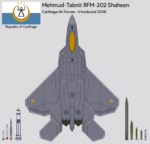
|
Fifth-generation stealth fighter designed to replace the RFM-201 Gyrfalcon for both air and sea use. In addition to the land and sea-based multi-role variants, a single-seat air defense variant also exists. | ||
| RFV-204 Kestrel | VTOL fighter | RFV-203DM | 550 | 
|
VTOL fighter designed for operation aboard light carriers and other space-constricted vessels, operated only by the Navy. The RFV-204 is in the process of being replaced by the RFV-205 Hawk. | ||
| RFV-205 Hawk | VTOL fighter | RFV-205 | 480 | File:Cddr mda-ngc-bae 005.jpg | Fifth-generation stealth VTOL fighter designed for use aboard light carriers. The RFV-205 is only operated by the Navy and shares a number of components in common with the RFM-202 Shaheen. | ||
Bombers
Strategic
| Strategic bombers | |||||||
|---|---|---|---|---|---|---|---|
| Name | Origin | Role | Version | Quantity | Photo | Notes | |
| RBL-230 Condor | Strategic bomber | RBL-230AM2 | 479 | 
|
Four-engine conventional strategic bomber expected to be retired by 2035, partially replaced by the RBM-234 Specter as well as unmanned platforms in the strategic strike role. | ||
| RBM-233 Phantom | Stealth bomber | RBM0-233 | 240 | 
|
Twin-engine stealth bomber designed to penetrate defended airspace. Expected to be partially replaced by the RBM-234 Specter beginning in 2025, with retirement expected in the 2040s. | ||
Tactical
| Strategic bombers | |||||||
|---|---|---|---|---|---|---|---|
| Name | Origin | Role | Version | Quantity | Photo | Notes | |
| RBS-232 Peregrine | Tactical bomber | RBS-232AM3 | 192 | 
|
Tactical bomber designed for interdiction strikes against enemy ground targets. The last units are expected to be retired by 2022 and replaced by a combination of strike fighters, stand-off munitions, and unmanned platforms. | ||
Ground attack
| Ground attack aircraft | |||||||
|---|---|---|---|---|---|---|---|
| Name | Origin | Role | Version | Quantity | Photo | Notes | |
| RFM-200TM Falcon Lite | Attack aircraft | RFM-200TM1N RFM-200TM1G RFM-200TM1T |
1,135 2,650 820 |
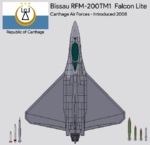
|
Lower-cost derivative of the RFM-200 Falcon for use in ground attack and supersonic lead-in fighter training roles. New airframes are expected to partially replace the Falcon in ground attack missions in conjunction with UAVs. | ||
| RGB-210 Sovnya | Attack aircraft | RGB-210DM1 | 448 | 
|
Introduced in 1985 as the AGB-31, the RGB-210 was the first dedicated close air support aircraft operated by the Air Forces. The RGB-210 is currently being retired in favor of a combination of the RGB-211 Glaive, RFM-200TM Falcon Lite, and other ground attack platforms. | ||
| RBS-211 Glaive | ISR/Light attack aircraft | RGB-211 | 336 | 
|
Introduced in 2012 to take on the manned ISR and light attack roles for the Air Forces at a lower cost than legacy platforms, providing partial replacement for the RGB-210 Sovnya. The type has also been procured as a subsonic trainer for fighter aircrews. | ||
| RTS-223G Razor | Gunship | RTS-223G | 48 | 
|
Gunship armed with a combination of autocannons, a light mortar, and hardpoints for precision guided munitions. | ||
Airlifters
Strategic
| Strategic airlifters | |||||||
|---|---|---|---|---|---|---|---|
| Name | Origin | Role | Version | Quantity | Photo | Notes | |
| RTS-222 Pelican | Strategic airlifter | RTS-222AM1 RTS-222DM1 |
349 867 |
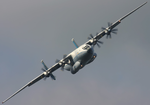
|
Licensed variant of the Russian Antonov An-22 airlifter, introduced in 1975 as the ATT-57. | ||
| RTS-224 Albatross | Strategic airlifter | RTS-224 | 568 | Replacement for the RTS-222 Pelican airlifter, with variants planned to take on roles from tanker to electronic warfare using the same base airframe. | |||
| RTS-225 Cronus | Strategic airlifter | RTS-225 | 248 | Super-heavy strategic airlifter built to supplement the RTS-224 Albatross fleet. Designed to carry extremely heavy or outsize cargo externally or internally in support of rapid deployment corps. | |||
Tactical
| Tactical airlifters | |||||||
|---|---|---|---|---|---|---|---|
| Name | Origin | Role | Version | Quantity | Photo | Notes | |
| RTS-220 Rogue | Tactical airlifter | RTS-220AM3 | 314 | 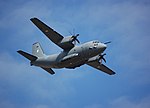
|
Light tactical airlifter to support intra-theater transportation needs with a focus on austere airfield capabilities. | ||
| RTS-221 Raven | Tactical airlifter | RTS-221AM3 RTS-221DM1 |
453 778 |
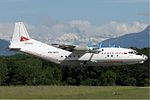
|
Licensed variant of the Russian Antonov An-12 airlifter, originally classified as the ATT-50. Slated to be fully replaced by the RTS-223 Razorbill by 2028. | ||
| RTS-223 Razorbill | Tactical airlifter | RTS-223 | 447 | 
|
Replacement for the RTS-221 Raven airlifter, with variants planned to take on roles from tanker to electronic warfare using the same base airframe. The RTS-223 brings significantly improved payload capacity, allowing for the transport of Iliad MMTV series vehicles. | ||
Passenger
| Passenger aircraft | |||||||
|---|---|---|---|---|---|---|---|
| Name | Origin | Role | Version | Quantity | Photo | Notes | |
| RTP-230 Skyliner | VIP/Passenger aircraft | RTP-230 RTP-230S |
16 4 |

|
VIP transport aircraft used for the transportation of the suffetes and other government officials along with their staff. Due to the importance of the usual passengers, RTP-230 Skyliners are equipped with onboard electronic countermeasures for self-defense. | ||
| RTP-231 Metroliner | VIP/Passenger aircraft | RTP-231AM2 | 48 | 
|
Used for short range passenger transport, especially to smaller airfields. Also has provisions to carry litters to evacuate wounded personnel. | ||
| RTP-232 Starliner | VIP/Passenger aircraft | RTP-232 | 48 | 
|
Medium-capacity passenger transport used by senior military and government officials. The larger size of the RTP-232 compared to the RTP-231 and -233 allows use as a mobile office and includes secure communications facilities for command and control functions. | ||
| RTP-233 Superliner | VIP/Passenger aircraft | RTP-233 | 24 | 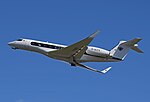
|
Larger passenger transport used to supplement the RTP-231 for longer journeys. | ||
Electronic support
Command and control
| Command and control | |||||||
|---|---|---|---|---|---|---|---|
| Name | Origin | Role | Version | Quantity | Photo | Notes | |
| RES-280 Ninja | Airborne early warning and control | RES-280AM2 | 188 | 
|
AEW&C platform introduced in 1974, based on the commercial Cordoba TFV-320 quadjet airframe. It provides mobile all-weather air surveillance, command, control, and communications capabilities to forces within its operating range. The platform is in the process of being replaced by the RES-282 Shogun, with the last types expected to be retired in 2028. | ||
| RES-281 Daimyo | Airborne ground surveillance | RES-281AM1 | 96 | 
|
Ground surveillance aircraft built on the airframe of the Mehmud-Tabnit R-500 regional airliner. Using ground-looking radar, the RES-281 is designed to provide standoff ground surveillance capability using its onboard AW/EGR-1776 side-looking radar. The design was quickly introduced to service in the 1990s as similar European platforms were adopted. Unlike the RES-280, battle management is expected to be handled on the ground rather than onboard. The type is expected to be replaced by the RES-282 Shogun, with the first units scheduled for retirement in 2020. | ||
| RES-282 Shogun | Multi-role electronic support | RES-282A | 16 | Replacement design for the RES-280 Ninja and RES-281 Daimyo support aircraft, using the modern TFV-400 airframe. The design is planned to consolidate the functions of multiple separate aircraft with greater capability, supplemented by unmanned platforms for greater coverage. | |||
Communications and support
| Electronic support aircraft | |||||||
|---|---|---|---|---|---|---|---|
| Name | Origin | Role | Version | Quantity | Photo | Notes | |
| RCS-290 Stentor | Airborne communications node | RCS-290A RCS-290B |
24 48 |

|
Originally developed as a high-altitude, long-endurance aerial communications node to provide trunking and dissimilar network integration capabilities for air, sea, and ground forces, the RCS-290 platform has also been adapted for standoff electronic warfare roles in the RCS-290B variant. | ||
Reconnaissance
| Reconnaissance aircraft | |||||||
|---|---|---|---|---|---|---|---|
| Name | Origin | Role | Version | Quantity | Photo | Notes | |
| RBS-231 Super Merlin | Reconnaissance aircraft | RBS-231AM3 | 44 | 
|
Originally developed as a high-altitude, supersonic strategic bomber, the AEB-24 Merlin was converted to the strategic reconnaissance role in the 1980s with the AM2 refit, later modernized in the early 2000s to the AM3 baseline with improved self-defense systems and new sensors. All bomber-variant aircraft were retired in 1993. | ||
| RRH-270 Eagle Eye | Reconnaissance aircraft | RBS-231AM3 | 128 | 
|
Subsonic high-altitude reconnaissance and surveillance aircraft introduced in 1984. | ||
Maritime patrol
| Maritime patrol aircraft | |||||||
|---|---|---|---|---|---|---|---|
| Name | Origin | Role | Version | Quantity | Photo | Notes | |
| RMP-265 Umineko | Maritime patrol aircraft | RMP-265 | 374 | 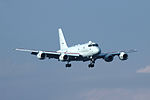
|
Maritime patrol aircraft developed in Japan and produced in Carthage under license and with domestic electronics. | ||
Trainers
| Electronic support aircraft | |||||||
|---|---|---|---|---|---|---|---|
| Name | Origin | Role | Version | Quantity | Photo | Notes | |
| RFM-200TM Falcon Lite | Supersonic jet trainer | RFM-200TM1N RFM-200TM1G RFM-200TM1T |
1,135 2,650 820 |

|
Supersonic lead-in fighter trainer used by fighter pilot trainees. Replaces the TFS-90 Shine supersonic trainer. | ||
| RBS-211 Glaive | Subsonic jet trainer | RGB-211 RGB-211T |
336 | 
|
Subsonic jet trainer procured alongside the RPL-240 Blue Jay. Training variants omit many of the more advanced sensor systems aside from those required for familiarization and are optimized for lower life-cycle costs and shorter range. The RBS-211 is operated exclusively by the Carthage Air Forces. | ||
| RPL-240 Blue Jay | Transonic jet trainer | RPL-240 | 752 | 
|
Transonic trainer with light attack capabilities used for combat pilot training (including fighter, bomber, and attack aircraft pilots). First fielded by the Carthage Air Forces in 2005 and by the Punic Navy in 2007 to replace the TFT-92 Sparrow. | ||
| RPT-241 Mamo | Turboprop trainer | RPT-241 | 1,142 | 
|
Basic aviation trainer. First ordered in 1992 and used by all pilot trainees across all branches. Although a light attack variant has been proposed, it has not been procured. | ||
| RPT-242 Finch | Multi-engine trainer | RPT-242 | 1,124 | 
|
Advanced pilot training aircraft used for bomber, airlifter, and other multi-engine aircrew training by all branches of the Defense Forces. | ||
Helicopters
Attack
| Attack helicopters | |||||||
|---|---|---|---|---|---|---|---|
| Name | Origin | Role | Version | Quantity | Photo | Notes | |
| QAH-47 Hoplite | Attack helicopter | QAH-47AM2 QAH-47AM3 |
1,400 3,200 |

|
Twin-engine attack helicopter introduced in 1987. In the process of being replaced by the newer QAH-54 Phalangite. | ||
| QAH-54 Phalangite | Attack helicopter | QAH-54 | 3,150 | Triple-engine attack helicopter introduced in 2008, replacing the QAH-47 Hoplite. | |||
Reconnaissance
| Reconnaissance helicopters | |||||||
|---|---|---|---|---|---|---|---|
| Name | Origin | Role | Version | Quantity | Photo | Notes | |
| QRS-44 Perioeci | Observation helicopter | QRS-44 | 3,200 | 
|
Armed scout and observation helicopter designed in Japan and produced domestically in Carthage. The QRS-44 was introduced due to delays in the QLR-53 Peltast program but with the introduction of the QLR-53, production of the QRS-44 was halted and existing QRS-44s are being transferred to reserve and militia units. | ||
| QLR-53 Peltast | Armed reconnaissance helicopter | QLR-53 | 3,500 | 
|
Stealth reconnaissance helicopter introduced in 2006. Delays in the QLR-53 Peltast program resulted in the interim procurement of the QRS-44 Perioeci but the expected full production rate was reached in 2008. | ||
Utility
| Utility helicopters | |||||||
|---|---|---|---|---|---|---|---|
| Name | Origin | Role | Version | Quantity | Photo | Notes | |
| QMS-50 Seabird | Utility helicopter | QMS-50 Tern QMU-50 Petrel QMS-50AM1 Gannet |
1,280 16,500 1,390 |
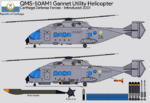
|
Three-engine utility helicopter designed to replace the Sikorsky SH-3 Sea King in Punic Navy service and later adopted by the Army and Air Force as utility helicopters. While all models are based on the same airframe and powerplant, different variants may incorporate different rear fan and compound wing configurations. | ||
| QHU-51 Kittiwake | Heavy lift cargo helicopter | QHU-51 | 2,200 | 
|
Heavy three-engine cargo helicopter designed to move large, bulky, and heavy cargoes over long distances. The QHU-51 is operated primarily by the Army with a small number in service with the Punic Navy for minesweeping purposes. | ||
| QHU-52 Cassowary | Heavy lift cargo helicopter | QHU-52 | 200 | 
|
Super-heavy cargo helicopter designed to support the movement of large components and the recovery of downed aircraft including helicopters in remote locations. Operated exclusively by the Army in dedicated aviation units. | ||
Trainers
| Training helicopters | |||||||
|---|---|---|---|---|---|---|---|
| Name | Origin | Role | Version | Quantity | Photo | Notes | |
| QPT-46 Numidian | Training helicopter | QPT-46 | 3,450 | 
|
Light twin-engine helicopter used for pilot training in all branches of the Defense Forces. Based on the Menochir S450, the QPT-46 has relatively limited military modifications and is not designed for combat use. | ||